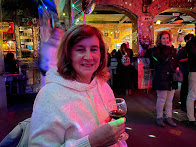PARTY ANIMALS?
Full discloser: Your favorite wanderers certainly can’t burn the candle at both ends, at least not at our advanced age, but in Budapest we didn’t stand a chance with keeping up with the revelry. Expecting a Communist-era dreariness to the Hungarian capital, Budapest instead is a vibrant city with more to offer than ornate buildings from the Hapsburg dynasty era and lots of history.
 |
| Budapest |
Full discloser: Your favorite wanderers certainly can’t burn the candle at both ends, at least not at our advanced age, but in Budapest we didn’t stand a chance with keeping up with the revelry. Expecting a Communist-era dreariness to the Hungarian capital, Budapest instead is a vibrant city with more to offer than ornate buildings from the Hapsburg dynasty era and lots of history.
A thriving nightlife of
live music venues, raucous nightclubs and trendy (swanky) rooftop bars
overlooking the city, and trendy (hipster) Ruin bars that are found in the old
Jewish quarter of the city awaited us as well as a lively thermal bath scene
that was packed even in the middle of winter!
Budapest lived up to
the hype of being a party destination and though we “tried” to enjoy some of
the antics we just couldn’t compete! There were two attractions that everyone visiting
Budapest should experience.
ROCKING THE ROMKOCSMA
The Ruin Bars are a number of drinking establishments that have been opened in previously neglected pre-war buildings in the Jewish Quarter. They are very trendy and so popular it is mostly overrun by tourists and backpackers and foreign students rather than locals, but are so off beat and bizarre it should be on your list to go...no matter your age.
 |
| Szimpla entrance |
Szimpla Kert was the
first Ruin Bar (romkocsma in Hungarian) to open in the old derelict Jewish
quarter. It is a heavily graffitied warren of corridors and open spaces and nooks where there are 9 separate bars over two floors. There was live acoustic music when we were there. There was an open-air courtyard with old cartoons being projected on the side of the building in the middle
of this gritty but convivial complex. It is very tourist friendly and though there was a youthful vibe, there were plenty of older people (ahem) shuffling
through grabbing a beer or wine. In our research we saw Szimpla Kert and knew
we had to go. There is no entrance fee, and the place gets very crowded as the
night advances. We lingered awhile to listen to the acoustic group, scoring a
couple of seats near the alcove that served as a stage. We were able to pay for
our drinks with a credit card and the bartenders all spoke English.
 |
| Haver |
Near by to Szimpla Kert
is Karavan, a food truck courtyard where you can eat everything from Hungarian
to burgers to vegan food.
Szimpla Kert is not the
only ruin bar to be found in Budapest, but it is the most renown. The bar was crowded
while we were there, and it was an early Friday evening the first week of
January. In the summer the place must be packed to the gills.
FLOUNCING IN THE FÜRDŐ
Another unique
attraction of Budapest is the prevalent spa culture. There are numerous thermal
baths found throughout the city and are popular with locals and tourists alike
and early on we also decided we had to go to Széchenyi Gyógyfürdő.
Budapest lies on a
geographical fault line and where the hills of Buda mash up against the plains
of Pest thermal springs bubble up everywhere. It is said a thermal spring will
erupt if one pokes a hole in the ground anywhere around Budapest. Pest is the Slavic
word for furnace.
 |
| Széchenyi Gyógyfürdő |
The spa culture was started
by the Romans and during the century and a half rule by the Ottomans many
ornate bathhouses were built. Two still in operation today are the Rudas Baths
and the Kiraly Baths, but we wanted to go the most popular spa in Budapest, Széchenyi.
Opened in 1913 the ornate
neo-Baroque and neo-Renaissance baths feature three outdoor pools. One is a lap
pool where a swimming cap must be worn, while the other two are for soaking and
relaxing in the heated water. One of the outdoor pools also features a
whirlpool that whips you around. There are also 12 indoor pools of different temperatures,
including a cold plunge pool and saunas. Széchenyi Gyógyfürdő is the largest thermal
spa in the Budapest area and on a late Tuesday morning the first week of
January it was packed.
 |
| Széchenyi Gyógyfürdő |
No need to be shy about
this experience. You will find people of all ages and various degrees of bulges
and curves that frequent the baths and after seeing a couple of speedo-hiding
belly overhangs you’ll feel right at home.
SPARTY ON HAVERS
Now, the nighttime
revelry party held at Széchenyi on Saturday nights from mid-February to November
might be a bit more intimidating for some. Thankfully we didn’t have the chance to go, but
from the website it seems like a frenetic event combining a club atmosphere with
lights and music and the thermal baths. They call it SPARTY © (Spa-Party get
it). Check out their website. SPARTY is a whole separate entrance fee structure. Alcoholic drinks are available.
(“Haver” is Hungarian
for “dude”.)
To get the best view entering
Széchenyi enter on the far side of the golden dome to the entrance across the
street from the zoo. After paying and activating a waterproof wristband that lets
you through the turnstile and gives access to a locker, first go up the stairs
to get a beautiful captivating view of the Széchenyi complex, before going down
to change for the thermal waters. Just make sure you go to the right area. Férfi
is man in Hungarian, and női is woman.
Here’s a 3d model of Széchenyi,
There are several tiers
of entrance fees, depending on the time of day and whether you’d like a private
changing cabin and a massage. Before 5 pm weekdays the entrance fee with a
locker is HUF 9400 (about $25.00). After 5pm the price drops to HUF 9100. Széchenyi
is open until 10 pm. Not sure about how long SPARTY goes on though.
Don’t get a Standard
Package at HUF 29000, like we did. Though this package comes with flip-flops
(footwear is required), a disposable robe and towel, a swim cap and hair band
it boosts the price to nearly $80.00. Better to bring your own towel and a
shirt or robe to cover up when moving from pool to pool. Bring a bag to store your
wet clothes and spend that money in better ways. If needed you can buy a suit
at the bath house, but you must pay cash for that. Credit cards can be used for
the entrance fee and other amenities, or you can online in advance.
 |
| Széchenyi Gyógyfürdő |
Budapest card
This tourism card is
great for discounts on entrance fees to the baths, admissions to museums and free
public transportation, and guided tours. We briefly looked into that but
decided to pay for a private 1 ½ day tour instead. Otherwise, the card is a
great way to see a lot of Budapest and not spend a lot of money. Purchases are
made on the amount of time spent in the city, i.e. 72 hours, 120 hours… Széchenyi says they accept the card for daily
tickets.
Széchenyi is the most
famous thermal bath in Budapest, but there are several others in the city. Here’s
a website of all the thermal baths not just in the city but throughout Hungary.
PARTY POOPERS
We only scratched the
surface of this city, but at least we got to experience two of the main draws. Both
the ruin bars and the Széchenyi thermal baths were on the top of our list, but
there’s so much more to Budapest, which we’ll tell you about soon.
Thanks for reading.
Love Janet and greg
© 2023 by Gregory Dunaj















































